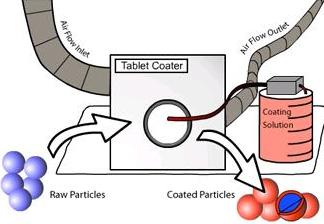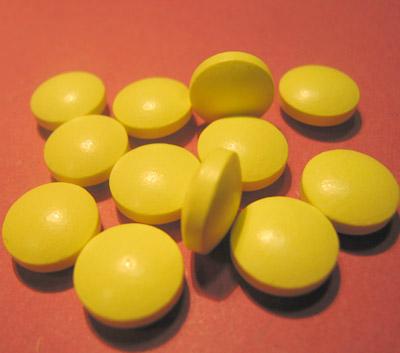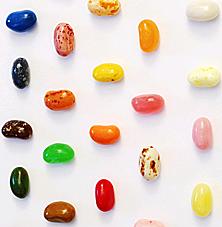Tablet coating is the process of evenly covering particles with a substance by applying a series of thin layers. These coaters differ in their function and application. These coaters are described with general information, equipment design, usage examples, and advantages/disadvantages.
Horizontal Pan
Layers of coating spray are applied to the particles until the desired thickness is achieved. For example, a coating of glaze gives candy its glossy sheen.

General Information
Tablets are loaded into the machine at the beginning of each batch. They tumble on a rotating drum while a coating liquid (solution, dispersion, or melt) sprays through nozzles onto their surface. Meanwhile, fans direct heated air through the tablets and the perforated drum, as shown below. This air either evaporates the solvent or cools the melt. Below are diagrams for fully perforated, to the left, and integrated plenum rotating pans, to the right. The integrated plenum pans operate effectively at lower airflows, which makes them better suited for solvent coating applications.

This process continues until the tablets are sufficiently coated, at which point they are discharged from the machine.
Equipment Design
Four systems make up a pan coater: the drum, the spray system, the charging mechanism, and the control system.
The Drum
The three key elements of a drum are its size, perforations, and baffles.
Research-size drums hold about 10 liters of material while industrial-scale drums can hold more than 2,000 liters, or about 2 tons of material. Some pan-coating machines will accept various drum sizes.
The size of the perforations restricts the size of tablets the drum is capable of processing. As the drum rotates, the baffles churn the tablets to prevent sticking and to ensure that they all receive an equal coating.

The Spray System
The core of the pan-coater, and most other coating machines, is the spray system. The more effectively the spray system atomizes the coating suspension, the more evenly the tablets get coated. Batch-to-batch consistency is a consideration in the pharmaceutical industry. Shown below are examples of spray systems.
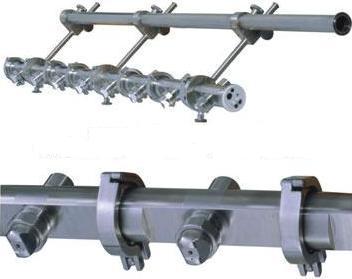
To achieve this optimal spraying, the nozzle is selected to suit the type of suspension being applied. Sugar coating machines conventionally use a rake, while aqueous and organic suspensions use binary nozzles.
Charging and Discharging Systems
To charge the pan, tablets are typically poured down a chute that empties into the drum. However, some applications require closed charging. In these cases, the tablets enter the machine through a pipe in the front or on top of the pan.
In open discharging a scoop is attached to the machine. The tablets are lifted out of the drum as it spins and are sent down a chute into a barrel or hopper, as shown below. Closed discharging requires a fixed discharge scoop that sends the tablets through a pipe and into a closed container.
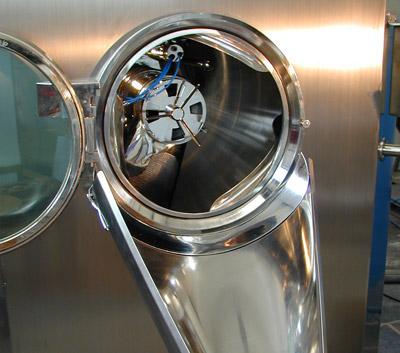
Control Systems
The machine must be monitored to ensure batch-to-batch consistency and quality. Modern coaters use computer software, such as the program pictured below, to achieve this. The computer can monitor a number of parameters, such as the temperature of the incoming air, the humidity, the drum spin rate, and the spray rate.
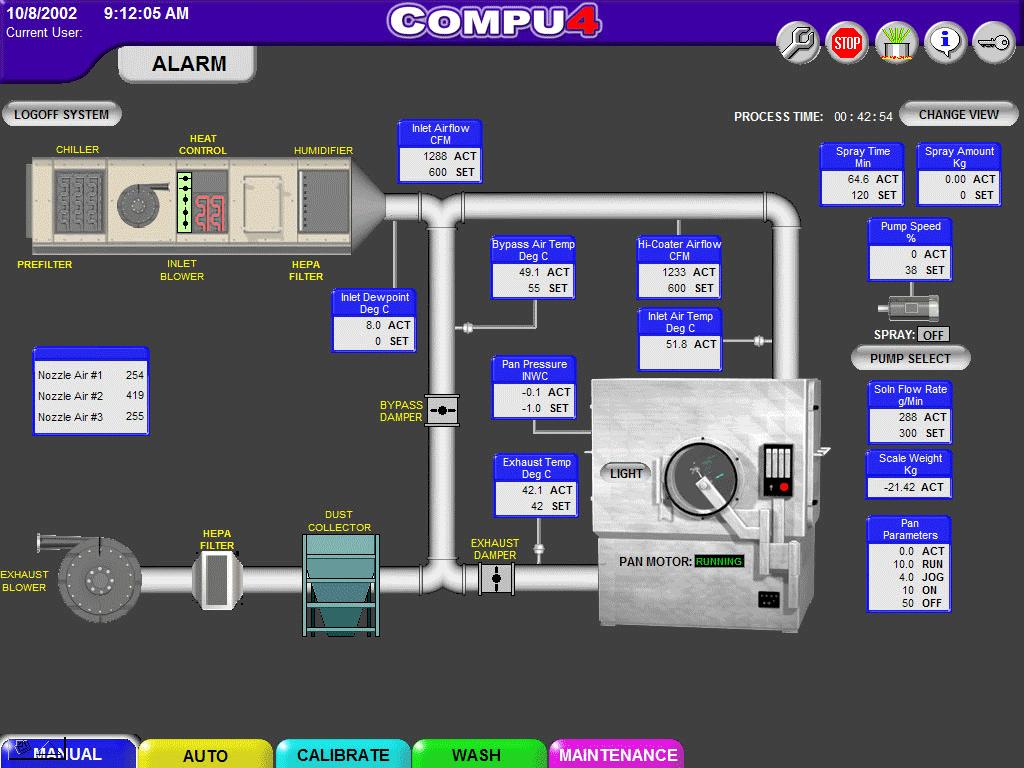
Computers are also capable of fully automating the process, from charging to discharging. The computer can store process instructions, or recipes, that yield specific results.
Usage Examples
Horizontal pan tablet coaters are used in the food, chemical, and pharmaceutical industries. They are used everywhere from small research operations to full-scale manufacturing.
Many prescription and over-the-counter medicines are coated with sugar to mask their smell and taste. Other types of films are used to modify the release profile of the drug.
Candy makers use horizontal pans to evenly coat each of their gourmet jelly beans with confectioner’s glaze.
Advantages
- Faster process times and larger batch sizes possible compared to fluidized bed.
- Standardized equipment allows for easy modification, upgrade.
- Low abrasion, good for delicate materials.
- Totally closed design meets CGMP standards.
- Handles large particles such as tablets and pellets.
Disadvantages
- Cannot mix as thoroughly or coat as evenly as a fluidized bed can.
- Entire drum must be replaced to suit the size of the particle being processed.
- Require costly, time-consuming cleaning when switching products.
- Limited range of particle sizes.
- Require more coating fluid to completely seal each particle.
Fluidized Bed
Layers of coating spray are applied to the fluidized particles until the desired thickness is achieved.
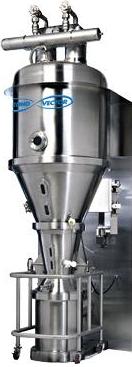
General Information
Tablets are loaded into the machine at the beginning of each batch. A fan forces air upwards and fluidizes the particles, while a nozzle sprays the coating liquid onto their surface. The air either evaporates the solvent, leaving behind a layer of coating, or cools the melt so that it solidifies. The diagram below shows a bottom-spray configuration, also known as a Wurster configuration.
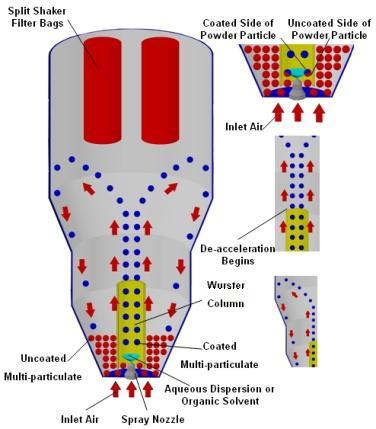
This process continues until the tablets are sufficiently coated, at which point they are discharged from the machine.
Equipment Design
A fluidized bed is composed of four systems: Air Handling, Spraying, Cleaning, and Control.
Air Handling
The air handling system removes any entrained product from the air before it leaves the system. By reducing the amount of product wasted, this system helps save money and avoid air pollution issues.
The two most prevalent devices used are bags, shown at the top, and cartridge filters, shown below. Usually, the cartridges or bags are installed in pairs, so that one can process air while the other is cleaned, thereby enabling continuous production.
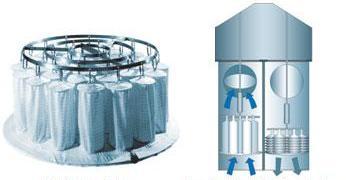
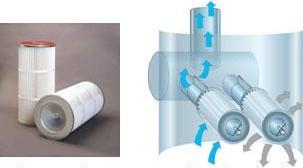
Spraying
The core of the fluidized bed coater is the spray system. The more effectively the spray system atomizes the coating suspension, the more evenly the tablets get coated. The spray can reach the particles from the top, the bottom, or the side.
In top spraying, the coating solution is applied counter-currently to the tablets’ motion, as seen on the right. After they are sprayed, the tablets fall back down in the bed. The fluidizing air evaporates the solvent, leaving behind a layer of coating. Once the tablets are dry, the process is repeated to achieve the desired thickness. This configuration generally allows for the highest throughput.
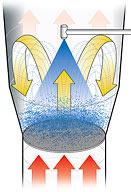
In side spray, or tangential, designs, such as the one below, the coating solution is introduced from the side of the bed, as tablets spin atop a rotor. The rotor supports the particles and agitates them to prevent agglomeration. This design offers consistent performance when batch-sizes fluctuate or when tablets are not uniform in size.
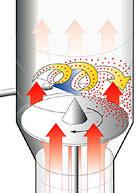
In bottom spray beds, also known as Wurster beds, the coating solution is applied co-currently to the upward-moving tablets within the center of the bed, as shown below. As the tablets rise, they enter an expansion chamber, where they begin to fall back and dry off. This design offers low product-abrasion, even coatings, and efficient delivery.
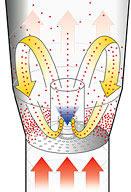
Cleaning
Cleaning is a regular part of fluidized bed operation. Operators often coat batches of several distinct products on any given day using a single bed. All traces of the previous product must be removed before beginning another batch.
Manufacturers often categorize fluidized beds based on their cleaning capabilities. Two common denotations are wash-in-place (WIP), and clean-in-place (CIP). WIP machines may be partially automated, but always require the machine to be opened and manually washed at some point. CIP signifies that the machine can automatically clean itself without being opened. Cleaning is often facilitated by a cleaning skid. This device controls the cleaning solution flow rate and temperature, to ensure consistent results. The diagram below shows a CIP system.
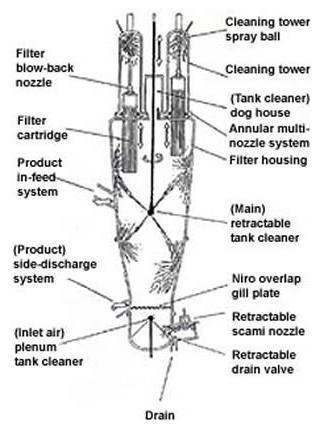
Control Systems
Fluidized beds must be monitored to ensure batch-to-batch consistency and quality. Modern coaters include computer-based systems, such as the one shown. The system can monitor a number of parameters, such as the temperature of the incoming air, the humidity, and the spray-rate.
Computers are also capable of fully automating the process, from charging to discharging. The computer can store process instructions, or recipes, that yield specific results. This type of program appears below.
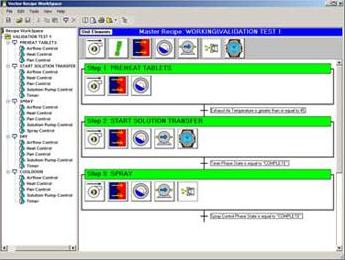
Usage Examples
Manufacturers primarily market fluidized bed coaters to the food and pharmaceutical industries. Drug manufacturers may apply active ingredients as a thin coating onto tablets. They may also coat the active ingredient with a film to modify its release- time in the body. The food industry uses the tablet coaters for taste masking and coloring as well. Fluidized beds offer a high degree of control over the thickness of these layers.
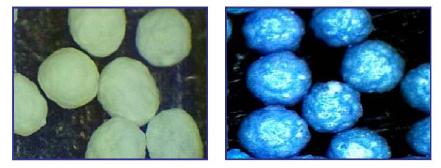
Advantages
- Can coat smaller diameter tablets than a horizontal pan.
- Coats more uniformly than horizontal pan.
- Relatively inexpensive to modify the spray configuration.
- Bed itself can also be used for granulation, spraying, drying, etc.
- Totally closed design meets CGMP standards.
Disadvantages
- About 1 mm maximum particle diameter.
- Volatile fluidized particles and solvents pose risk of explosion.
- Not suitable for sugar-coating.
- Cannot process batches as large as a horizontal pan.
Acknowledgements
- GEA Process Engineering Inc., Columbia, MD
- Glatt Group, Inc., Binzen, Germany
- Mendel Company, East Hanover, NJ
- Nicos Group, Inc., Norwood, NJ
- Vector Corporation, Marion, IA; now part of Freund-Vector
References
- Ghebre-Sellassie, Isaac, ed. Multiparticulate Oral Drug Delivery. Vol. 65. New York: Marcel Dekker, Inc., 1994. Print.
- Pietsch, Wolfgang. Agglomeration Processes . Weinheim: Wiley-VCH Verlag GmbH, 2002. Print.
- Satas, D., and Arthur A. Tracton, eds. Coating Technology Handbook. 2nd ed. New York: Marcel Dekker, Inc., 2001. Print.
Developers
- Rob Main
- Kelsey Kaplan
- Keith Minbiole

